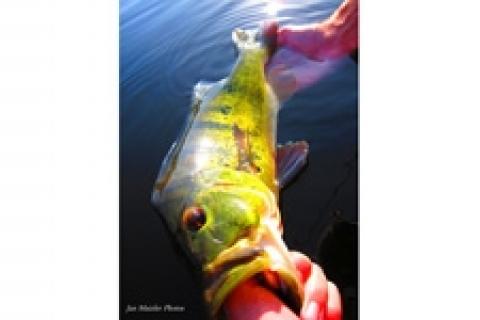
In discussing the trip with Lake Ida's Captain Butch Moser, I found out that his grandson David would be accompanying him on his Carolina Skiff as mate, co-captain, and apprentice guide. I was to find out shortly that David is an incredibly polite, efficient and friendly young man. Further, the day would prove the benefits of his actions covering baiting, rigging, and chumming while Butch was up on the bow working the electric motor.
The Fishing Day Begins
I picked up my friend Don Eichin in Miami at 5 a.m. so we could allot one hour for driving up to Lake Ida and also one hour for breakfast. We made the trip without any negative events and drove east on Atlantic Avenue to a Starbucks for an early meal and coffee. It was good to know as we were munching away that Butch was setting up a great day by cast-netting loads of live shad for the enormous livewell on his skiff. Butch generally gave himself at least an hour to sufficiently mark the baitfish on the recorder and cast-net them. A liberal span of time would be essential for adjusting for the sometimes daily movements of the bait, but most important of all was the magic moment of dawn when the baitfish schools typically rise and be most vulnerable to netting. On his bow-mounted, back-lit depth recorder, the bait showed up as a "cloud" on the screen.
We finished our meal and arrived about a half-hour early at the Lake Ida boat ramp. In the distance, we could see Butch and David in silhouette as they caught bait. This gave me an excellent chance to do some low light photography as the first lumes of dawn peaked over the eastern horizon. But time waits for no one and at seven o' clock, we could see them crank up the skiff and traverse the hundred yards to the dock where we were waiting. As David tied off the skiff, we climbed aboard and gave greetings.
Don and I each had brought aboard our own 4-pound and 6-pound spinning rods. And we both knew that Butch would set up two kinds of rigs. One type was rigged "free" with a fine wire, bronzed, long shank, size 2 Aberdeen fishing hook. The thin gauge of the wire was essential for two reasons. The first was to create a hook light enough to not hamper the swimming motions of the live shad. The second basis for the light gauge wire was to have metal thin enough to be "driven home" by the ultralight line, which was no stronger than 4- or 6-pound test. With the first outfit, the presentation depth of the live shad was created by the hook placement as well as line control. The second outfit had the same hook, but was rigged with a small adjustable float initially placed three feet above the business end. A tiny split shot was pinched right above the hook to ensure straight down bait suspension under the float.
The running time to our first spot was short, but not too brief to keep Don and I from being fully rigged as Butch cut the big engine and went to the bow to lower his electric trolling motor to give us more quiet propulsion. They instructed Don and I to slow troll our live baits along the seawall drop off of a skinny canal. In short order we both had strikes and after a good tussle, reeled in sunshine bass of 4 pounds. Butch lowered his mushroom anchor and joined us fishing to both sides of the canal. David started live-chumming and we soon had a feeding frenzy going of sunshine bass, plus largemouths up to 6 pounds. At times, we had triple headers. This madness went on for two hours, enabling us to release about 50 scrappers. I asked Butch about catching some peacock bass and he replied that he was waiting for the water to warm up more and for the sun to get higher. He felt the conditions would be better in about an hour, so we fished through that period, releasing another 20 sunshine and largemouth bass.
Butch told us to reel in our baits and fired up his engine. After we sat down and got comfortable, he ran westward to a very long canal. Again, he cut his engine and got back on his "electric." The strategy here was to pitch our live baits to the shadows of the many docks and boats that lined this canal — this would be a huge challenge for me to keep using my 4-pound outfit, but I insisted on it! It would turn out that there were peacocks ready, willing, and able along most of the structure. Both Don and I hooked up often but only at a 50 percent success rate because of light line cutoffs or exploding strikes by the peacocks that actually knocked the baits away from them. We ended the morning by releasing about 30 peacocks up to 5 pounds.
It was a wonderful morning of fishing and we made another appointment to fish with Butch and David in two weeks. We were sure to tell them we wanted to start the day pursuing the wily rolling and jumping clown knife fish. And though we all agreed to that plan, we had no idea what success with this rare species we'd attain in short order!
About Butch Moser
Butch runs a 20 foot-Carolina Skiff powered by a 90HP Yamaha. His vessel is extremely spacious and can accommodate a few anglers. The vessel is very stable and suited to fun fishing in freshwater with ultralight tackle and lots of frisky live bait.
- 2220 views

